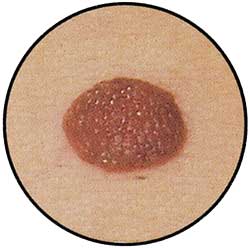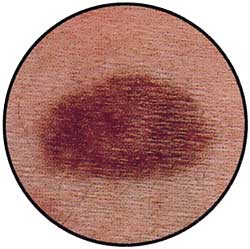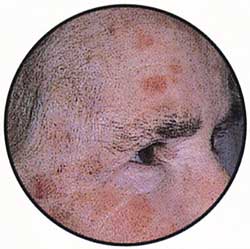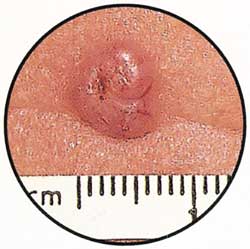Summary Statement
Describes the dangers of ultraviolet radiation, ways to minimize exposure and signs of skin cancer including images.
summer 2001
In recent years there has been growing concern over the health risks of exposure to the sun's ultraviolet (UV) radiation. Construction workers are particularly at risk because they often work outdoors.
Long-term health risks of UV exposure include:
- skin cancers
- eye damage
- weakening of the immune system
- premature aging of the skin.
Melanoma in men rising faster than any other cancer. |
Skin Cancers
Every year, there has been an alarming increase in the incidence of skin cancer. Sunlight is the main source of ultraviolet radiation (UV) known to damage the skin and cause skin cancer. Exposure to the sun's UV radiation is widely recognized as a highly preventable cause of skin cancer. Studies show that people who work outside, such as construction workers, are at risk for developing skin cancer and need to be educated on the damaging effects of the sun and how to protect themselves.
Melanoma is the least common but most dangerous type of skin cancer. The incidence of melanoma in men is rising faster than all other cancers.
According to the Canadian Dermatology Association (CDA), the mortality rate from malignant melanoma is increasing, particularly in middle-aged males.
Melanomas most often appear on the upper back, head, and neck. The CDA also notes that there is generally a lag time of 10 to 30 years for the clinical appearance of skin cancer to occur.
Consequently, it is critical for young workers to beware of the cumulative effect of unprotected sun exposure. The more time they spend unprotected in the sun, the higher the risk of developing skin cancer.
Although most construction workers generally cover up their arms, legs, and torso on site, their faces and necks are still exposed to the sun's harmful rays. In addition, areas like the tips of the ears and the lips are often overlooked when it comes to sun protection.
The type of skin cancer that develops on the ear or the lip has a high chance of spreading to other parts of the body and causing death. Melanoma may also occur on the sun-exposed parts of the head and neck. In fact the majority of skin cancers (2 out of 3) occur on the head and neck, followed by the forearm and back of the hand. Workers too often leave these critical areas exposed to the harmful effects of UV radiation.
Individual risk factors for developing skin cancer include:
- fair skin that burns easily
- blistering sunburns in childhood and adolescence
- family history of melanoma
- many freckles and moles.

Wide-brim hard hats help to shade skin and eyes as
well as protect against rain and falling debris.
Eye damage from overexposure to sunlight may cause short-term and long-term health effects.
Short-term effects may be:
- frequent blinking and watering of the eyes
- intolerance to strong light
- blurred vision.
Long-term effects include:
- growth of the eye lining (conjunctiva) to the point where it interferes with vision
- cataracts that cloud vision.
Recent research shows that overexposure to UV radiation decreases the body's ability to fight bacteria and viruses. This makes the body more susceptible to infection and illness.
Skin AgingConstant exposure to the sun accelerates the skin's aging process, resulting in blemishes and wrinkles.
Additional Risk FactorsIn addition to the harmful effects of the sun's direct rays, some workers may be exposed to indirect UV radiation. Workers can receive additional radiation if they are on or near a surface that reflects sunlight (see front cover). Reflective surfaces such as concrete, water, unpainted corrugated steel, building glass, and aluminum can increase the amount of ultraviolet radiation to which a worker is exposed.
Another source of indirect UV radiation is from the hard hat itself. UV rays can reflect off the hard hat onto a worker's face, magnifying the amount of UV exposure.
Although all construction workers are at risk, those who don't have ready access to shade and/or work at heights are at a higher risk for UV overexposure. These trades include:
- concrete finishing workers
- roofers
- rodworkers
- formworkers on high-rise and residential sites
- roadworkers
- traffic signallers
- ironworkers
In addition, working at sites with southern exposure limits the daytime shade available and increases UV exposure.
Even indirect exposure can be harmful.
Remember–even on cloudy or hazy days,
UV radiation can penetrate the atmosphere
and burn your skin. |
What Workers Can Do
- Apply a broad-spectrum sunscreen with a sun protection factor (SPF) of 15 or greater to all exposed skin areas. Be sure to cover your ears and the back of your neck. Apply sunscreen 20 to 30 minutes before you go out in the sun. Reapply sunscreen every 2 hours.
- Use an SPF 15 or higher sunscreen lip balm and reapply every two hours. Skin cancers can develop on lips.
- You may add UV protection to the back of your neck by using fabric to block the sun's rays. Neck protectors that clip onto your hardhat are available.
- Wear UV-absorbent safety glasses (CSA-approved polycarbonate glasses incorporate this feature).
- Wear clothing that covers as much of the skin as possible. Tightly woven material will offer greater protection as a physical block to UV rays.
- If you perspire heavily, you may need to reapply sunscreen more often. Additionally, when clothing is wet, it loses some of its ability to block out the sun's rays. Ensure you have additional dry clothing if necessary.
- Try to find a shaded area for your breaks and lunch.
- Wear a wide-brim hard hat designed to protect your face and neck from the sun. Adding a glare guard under the peak of your hard hat will help reduce reflected UV rays.
- Examine your skin regularly for any unusual changes. The most important warning sign for skin cancer is a spot on the skin that is
changing in size, shape, or colour. The danger signs include any wound or skin patch that doesn't heal properly or scales. Be particularly attentive to any mole that grows or becomes irregular in shape, especially if it is multi-coloured. If anything looks unusual, see your doctor as soon as possible. Skin cancers detected early can almost always be cured.

Spot Check
Normal mole: round or oval, even colour. Many moles - increased risk of melanoma skin cancer. |
Atypical mole: mix of browns, smudged border, often bigger than than 5mm. Increased risk of melanoma skin cancer |
 |
 |
Melanmoma Skin Cancer: Potentially Deadly |
|
COLOUR - new colour, black, brown, red, blue or white. |
|
 |
|
SHAPE- irregular border scalloped but well-defined |
SIZE- enlarges |
 |
 |
Actinic Keratoses - not skin cancer. Indicates excess sun exposure over many years. Red, rough, scaly spots, may itch or sting. Increased risk of skin cancer. |
 |
Basal cell skin cancer: can cause disfigurement. Flesh-coloured, red or black, round bumpwith a pearly border, develops into ulcerating sore. |
 |
Squamous skin cancer: Can be life-threatening Thickened, red, scaly bump or wart-like growth, develops into a raised, crusted sore. |
 |
Common skin cancers usually appear on sun exposed areas. |
 |
See you dermatologist if you note any of the above |
Spot Check courtesy of Canadian Dermatology Association |
What Employers Can Do
-
Supply workers with a broad-spectrum sunscreen with an SPF of 15 or higher.
-
Ensure adequate shaded areas for workers on breaks and lunch.
-
If possible, rotate workers to shaded areas of the jobsite.
-
Educate workers on the hazards of UV radiation.
-
Ensure that workers use UV-absorbent safety glasses.
The majority of skin cancers are preventable. Taking basic precautions can significantly reduce the health effects of chronic sun exposure. |


